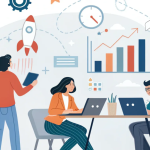AI-First Software Engineering: The New Frontier
Adopting an AI-first approach in software engineering is not just about using new tools; it’s about fundamentally transforming the entire software development lifecycle. This shift promises to enhance productivity, foster innovation, and empower engineers to tackle more complex challenges.
Introduction
The world of software engineering is on the cusp of a paradigm shift, driven by the transformative power of Artificial Intelligence. An “AI-first” approach is no longer a futuristic concept but a present-day reality for forward-thinking organizations. This isn’t simply about integrating AI-powered coding assistants into existing workflows; it’s a holistic strategy that redefines how we design, build, and maintain software. From initial scoping to long-term support, AI is poised to become an indispensable partner, augmenting human capabilities and unlocking unprecedented levels of efficiency and innovation. This article, inspired by the insights from Thoughtworks’ “Perspectives,” delves into what it truly means to embrace an AI-first software engineering culture, exploring its profound implications for developers, businesses, and the very nature of software delivery.
The Evolution of Software Engineering: Beyond Coding Assistants
The initial wave of AI in software development has been largely characterized by the adoption of coding assistants. While these tools have undeniably boosted developer productivity, they represent just the tip of the iceberg. True AI-first software delivery (AIFSD) extends far beyond mere code generation. It’s an end-to-end, iterative process that embeds AI into every stage of the software lifecycle.
A Holistic Approach to AIFSD
An AI-first mindset necessitates a shift in how we approach software development from the ground up. This includes:
- Product Scoping and Definition: Leveraging AI to analyze market trends, user feedback, and competitor landscapes to define product features and scope with greater accuracy.
- Design and Architecture: Utilizing AI to identify optimal design patterns, suggest architectural improvements, and even generate initial solution designs based on high-level requirements.
- Development and Testing: Going beyond code completion to include AI-powered test case generation, bug detection, and automated debugging, significantly reducing manual effort and improving code quality.
- Deployment and Maintenance: Employing AI for intelligent deployment strategies, proactive monitoring of production environments, and predictive maintenance to identify and address potential issues before they impact users.
Analogy: Think of a traditional software development team as a group of skilled craftspeople, each a master of their trade. An AI-first approach is like providing this team with an advanced, intelligent workshop where every tool is not only powered but also anticipates their needs, suggests improvements, and learns from their every action. The craftspeople are still in charge, but their capabilities are amplified, allowing them to create more complex and beautiful things than ever before.
The Impact on Legacy Modernization
One of the most promising applications of AIFSD is in legacy modernization. Many organizations are saddled with aging, complex systems that are difficult to understand, maintain, and evolve. AI can play a crucial role in:
- Code Analysis: Analyzing vast codebases to identify dependencies, uncover hidden business logic, and create comprehensive documentation.
- Automated Refactoring: Suggesting and even automating code refactoring to improve maintainability, performance, and security.
- Migration Strategies: Assisting in the planning and execution of migrations to modern, cloud-native architectures.
Rethinking the Benefits: More Than Just Productivity
While productivity gains are often the primary driver for adopting AI in software engineering, the true benefits of an AI-first approach are far more transformative.
Enhancing the Entire Feedback Loop
As noted by Martin Fowler, Chief Scientist at Thoughtworks, “Acceleration can impact not just the development of software, but the whole software feedback loop.” This means that AI can help us not only build things faster but also learn from them more quickly. By analyzing user behavior, monitoring application performance, and gathering feedback from various channels, AI can provide invaluable insights that inform future development cycles, leading to more impactful products and services.
Empowering Engineers and Fostering Innovation
Contrary to the fear that AI will replace developers, an AI-first approach actually empowers them. By automating tedious and repetitive tasks, AI frees up engineers to focus on higher-value activities such as:
- Creative Problem-Solving: Tackling more complex and challenging problems that require human ingenuity and critical thinking.
- Strategic Thinking: Contributing to product strategy, architectural decisions, and long-term technical vision.
- Collaboration and Mentorship: Spending more time collaborating with team members, mentoring junior developers, and sharing knowledge across the organization.
Statistic: A survey revealed that over 90% of software developers are already using AI tools in some capacity, both inside and outside of work, highlighting the rapid adoption and perceived value of AI in the developer community.
Navigating the Risks and Reinventing the Engineer
The adoption of AI in software engineering is not without its challenges. It’s crucial to be aware of the potential risks and to proactively address them.
The Double-Edged Sword of AI
AI tools can amplify both solutions and problems. If an AI is trained on low-quality code, it will produce low-quality code. Therefore, it’s essential to ensure that AI tools are used responsibly and that their outputs are carefully monitored and validated by human experts. This requires a strong foundation of software engineering best practices, including:
- Clean Code: Writing clean, well-structured, and maintainable code that can be easily understood and processed by both humans and AI.
- Test-Driven Development (TDD): Writing tests before writing code to ensure that the code is correct and that it meets the requirements.
- Continuous Integration and Continuous Delivery (CI/CD): Automating the build, test, and deployment process to ensure that code changes are delivered to users quickly and reliably.
The Evolving Role of the Software Engineer
In an AI-first world, the role of the software engineer is evolving. It’s no longer just about writing code; it’s about orchestrating a complex system of human and artificial intelligence to deliver value to users. This requires a new set of skills, including:
- Prompt Engineering: The ability to craft effective prompts that elicit the desired output from AI models.
- AI Model Training and Fine-Tuning: Understanding how to train and fine-tune AI models to meet the specific needs of a project or organization.
- Critical Thinking and Problem-Solving: The ability to critically evaluate the outputs of AI tools, identify their limitations, and solve complex problems that AI cannot.
Statistic: According to Gartner, 80% of the software engineering workforce will need to be upskilled because of AI, highlighting the urgent need for continuous learning and adaptation.
Future Use Cases and the Road Ahead
The potential applications of AI in software engineering are vast and continue to expand. In the future, we can expect to see AI play an even more significant role in areas such as:
- Generative AI for Software Development: AI models that can generate entire applications from natural language descriptions, further accelerating the development process.
- AI-Powered Security: AI tools that can automatically identify and remediate security vulnerabilities in real-time.
- AI for Ethical and Responsible Software Development: AI that can help developers identify and mitigate potential biases in their code and ensure that their applications are fair, transparent, and accountable.
The Importance of Responsible AI
As we entrust more and more of the software development process to AI, it’s crucial to ensure that we do so responsibly. This means:
- Transparency: Understanding how AI models work and being able to explain their decisions.
- Fairness: Ensuring that AI models are not biased against certain groups of people.
- Accountability: Establishing clear lines of responsibility for the outputs of AI models.
Conclusion
The journey to AI-first software engineering is an acceleration of established principles, not a replacement of them. It’s about empowering engineers, enhancing collaboration, and delivering better software, faster. By embracing a holistic, end-to-end approach to AIFSD, organizations can unlock the full potential of AI, driving innovation, and gaining a significant competitive advantage. The future of software development is a collaborative one, where human and artificial intelligence work together to create a new generation of intelligent, adaptive, and impactful applications.
Ready to embark on your AI-first software engineering journey? Contact CloudBloq or Schedule Call today to learn how our experts can help you leverage the power of AI to transform your software delivery lifecycle and achieve your business goals.
FAQs
What is an AI-first approach in software engineering?
An AI-first approach in software engineering is a strategy that integrates artificial intelligence into every stage of the software development lifecycle, from initial planning and design to development, testing, deployment, and maintenance. It’s about leveraging AI to augment human capabilities, automate repetitive tasks, and drive innovation.
Will AI replace software engineers?
No, AI is not expected to replace software engineers. Instead, it is poised to augment their capabilities, freeing them from tedious and repetitive tasks and allowing them to focus on more creative and strategic work. The role of the software engineer will evolve, requiring new skills such as prompt engineering and AI model management.
What are the benefits of an AI-first approach?
The benefits of an AI-first approach include increased productivity, accelerated delivery cycles, enhanced code quality, improved developer experience, and greater innovation. It also allows organizations to make better use of their data and gain a competitive advantage in the marketplace.
What are the challenges of adopting an AI-first approach?
The challenges of adopting an AI-first approach include the need for new skills and training, the risk of amplifying errors if not implemented carefully, and the need for a strong foundation of software engineering best practices. It’s also important to address the ethical implications of AI and ensure that it is used responsibly.





